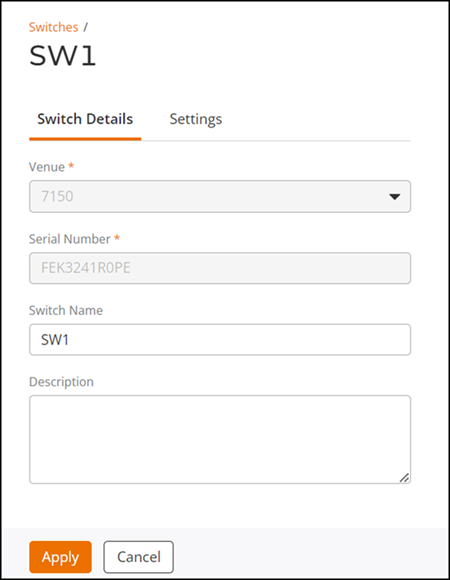Editing a Switch
You can configure the properties of a switch to optimize network performance, enhance security, and manage traffic more effectively.
Note: The venue and serial number settings cannot be
modified.
-
On the RUCKUS One web interface, navigate to Wired >
Switches > Switch
List.
The Switch page is displayed.
- From the list of switches, click the checkbox for the switch that you want to edit.
- Click Edit.The Switch Details tab is displayed.
Editing a Switch 
-
(Optional) Modify the switch
details.
- Switch Name: Edit the switch name.
- Description: Edit the switch description.
- Click Apply if you are only editing the switch details. Otherwise, proceed to the next step.
-
(Optional) Select the Settings tab.
On the Settings page, you can edit the following:
- IP Assignment
- DHCP: Dynamically assigns IP addresses to devices on a network.
- Static/Manual:
Manually configure the IP
Address, Subnet
Mask, and Default
Gateway IP addresses.Note: The IP address is the VE 1 IP address.
- Jumbo Mode: When enabled, this option allows transmission of jumbo frames on an Ethernet interface, improving network performance for applications that require high bandwidth data transfer, such as video streaming. Disabled by default, use the toggle to enable or subsequently disable this option.
- IGMP Snooping: Optimizes the delivery of multicast
traffic within a local area network (LAN). The following are the
available options:
- Active
- Passive
- None
- Spanning Tree
Priority: Spanning Tree Priority (STP) is a configurable
parameter on each switch. STP is used to determine the priority of the
switch in the spanning tree election process. Select the priority from
the drop-down menu.Note: Beginning with RUCKUS FastIron 10.0.20a and later, the Spanning tree protocol can be either set to RSTP or None, and the value of Spanning Tree Priority can be set to zero or increments of 4096.
- Static Routes: Static routes are manually configured routing enteris in the routing table of a switch. Click Add Route to add a static route. The Add Route side bar is displayed. Configure the Destination IP, Next Hop, and optionally, Admin Distance, then click Add.
- Authentication:
Disabled by default, you can enable or subsequently disable the
Authentication feature using the toggle. Once enabled, configure the
associated settings, such as Auth Default VLAN and Guest
VLAN.
The Authentication configuration settings are applied at the switch level, meaning all ports with Authentication enabled will inherit these settings unless custom settings are configured at the port level.
Port-specific custom settings override the switch-level settings. The Guest VLAN is exclusively a switch-level configuration.
- IP Assignment
- Click Apply to apply the configuration settings.